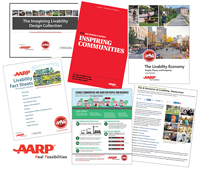x-AARP Livable Communities Principles
The priorities that guide our efforts
To support and guide efforts on Livable Communities issues, AARP’s Public Policy Institute has developed the following principles, which appear in Chapter 9 of the AARP Public Policy Book.
1. Create livable communities: Provide features and services designed to enhance the ability of residents with diverse needs to remain independent and actively engaged in community life including safe, appropriate, decent, affordable, and accessible housing, and comprehensive mobility options that include alternatives to driving (through transportation design, zoning, walkable neighborhoods, and technology infrastructure).
2. Improve health: Communities should provide access to healthy food options, opportunities for walking, biking and exercise, and connections to health facilities and related services and supports including home- and community-based supportive features and services. Governments should promote changes to the physical environment that improve health outcomes and minimize the negative health impacts of policies and actions affecting the built environment, particularly those with disproportionate impacts on vulnerable communities and populations, including older adults.
3. Foster safety and personal security: Governments should support and promote community safety and security initiatives that promote neighborhood cohesion and maximize opportunities for residents to be active and engaged with neighbors, family, and friends. Individuals play a role in making communities safe and secure through Neighborhood Watch programs and other collaborations with law enforcement, along with community activities that promote neighborhood cohesion and governments should support such activities.
4. Engage residents in community planning and provide equal access to the decision making process: Government land use, housing, and transportation/mobility decisions have broad effects on the lives of residents. Communities should put in place structures that ensure that these decisions are made only with the active input of a wide cross-section of community members, including representation of those unable to advocate on their own behalf. Community decisions on land use, housing, and transportation/mobility should be consistent with comprehensive plans that have been developed with ample public input. The costs and benefits of community decisions should be equitably shared within the community.
5. Protect civil and legal rights: Communities should promote policies and efforts to eliminate discrimination on the basis of income, race, national origin, disability, or other categories and ensure equitable rules, regulations, and funding decisions.
6. Coordinate planning processes: Community land use, infrastructure, housing, transportation, supportive services, and community health care planning each play a part in creating livable communities and promoting successful aging in place. Planning processes and decisions affecting these policy areas should be developed through a process that reflects their interconnectedness.
7. Invest in existing communities: Investment in existing communities must be efficient and beneficial to those who desire to age in place. Development resources should be strengthened and directed toward existing communities and community revitalization and economic development plans should include the needs of older adults.
Age-Friendly Communities Tool Kit Resources
Joining
- The Member List
See the current roster of enrolled communities in the United States as well as their action plans and other information
- Preparing the Membership Materials
Find the membership application, sample letters of commitment, resolutions and more
Learning
- AARP Network of Age-Friendly Communities Program Cycle
Download a visual overview of the program’s steps and elements
- AARP Age-Friendly Resource Guide
A selection of key resources to support age-friendly communities through all stages of the program cycle
- World Health Organization Guide to Age-Friendly Cities
Download this 82-page guide for a deep dive into the program
- Better Together: A Comparative Analysis of Age-Friendly and Dementia Friendly Communities
Read an AARP report and find links to related resources
Funding
- Age-Friendly Foundations
These funding organizations are helping make communities more livable
Evaluating
- Evaluating Your Age-Friendly Community Program: A Step-by-Step Guide
Use this resource when you're identifying indicators in your action plan
Sustaining
- Guiding Principles for the Sustainability of Age-Friendly Community Efforts
Learn how to maintain ongoing success
Stay Informed — For Free!
AARP.org/Livable
Enter a topic, name, place, etc.





